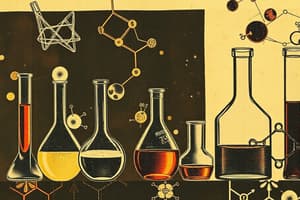Podcast
Questions and Answers
What is the final product formed in the Reimer-Tiemann reaction?
What is the final product formed in the Reimer-Tiemann reaction?
- Salicylaldehyde (correct)
- Phenol
- Chloroform
- Sodium hydroxide
What is the primary use of the Wurtz Reaction?
What is the primary use of the Wurtz Reaction?
- Formation of diazonium salts
- Preparation of aromatic compounds
- Preparation of alkanes from alkyl halides (correct)
- Introduction of halogens into the benzene ring
Flashcards
Sandmeyer's Reaction
Sandmeyer's Reaction
A reaction where aryl diazonium salts are reacted with copper(I) halides to replace the diazonium group with a halogen atom. This reaction is used for the synthesis of aryl halides.
Gatterman Reaction
Gatterman Reaction
A reaction where an aryl diazonium salt reacts with a halogen acid in the presence of copper powder to form an aryl halide.
Finkelstein Reaction
Finkelstein Reaction
A reaction used to convert alkyl halides into alkyl iodides by reacting them with sodium iodide in a solvent like acetone. The reaction utilizes le Chatelier's principle to favor the formation of the alkyl iodide.
Wurtz Reaction
Wurtz Reaction
Signup and view all the flashcards
Friedel-Crafts Alkylation
Friedel-Crafts Alkylation
Signup and view all the flashcards
Aldol Reaction
Aldol Reaction
Signup and view all the flashcards
Cannizzaro Reaction
Cannizzaro Reaction
Signup and view all the flashcards
Gabriel Phthalamide Synthesis
Gabriel Phthalamide Synthesis
Signup and view all the flashcards
Hoffmann Bromamide Reaction
Hoffmann Bromamide Reaction
Signup and view all the flashcards
Carbylamine Reaction
Carbylamine Reaction
Signup and view all the flashcards
Kolbe's Reaction
Kolbe's Reaction
Signup and view all the flashcards
Hinsberg Test
Hinsberg Test
Signup and view all the flashcards
Coupling Reactions
Coupling Reactions
Signup and view all the flashcards
Study Notes
Organic Reactions
- Sandmeyer's Reaction: Aromatic diazonium salts can be converted to aryl halides in the presence of copper(I) halides. Aryl halides are formed from benzene diazonium salts by treatment with copper(I) halides.
- Gattermann Reaction: Halogens can be introduced into the benzene ring of diazonium salts using copper(I) halides. The process uses copper(I) salts as a catalyst in the presence of halogen acids, leading to the formation of aryl halides.
- Balz-Schiumann Reaction: Aryl diazonium salts react with fluoroboric acid to furnish aryl fluorides.
- Finkelstein Reaction: Alkyl iodides can be prepared by reacting alkyl chlorides or bromides with sodium iodide. This reaction favors the conversion of alkyl chlorides or bromides to alkyl iodides.
- Swartz Reaction: Alkyl halides react with metallic fluorides to produce alkyl fluorides. Halogen exchanges in alcohol or alkyl compounds.
- Wurtz Reaction: Alkyl halides react with sodium to produce alkanes. Alkyl halides with sodium in an ether medium forms alkanes.
- Wurtz-Fitttig Reaction: Aryl halides react with alkyl halides with sodium to produce alkylbenzenes. Reaction of aryl halides with alkyl halides with sodium in an ether medium forms alkyl benzenes.
- Fittig Reaction: Aryl halides react with aryl halides with sodium to produce diarylmethane. This reaction occurs in an ethereal solvent.
- Friedel-Crafts Alkylation: Alkyl halides can be used to alkylate aromatic rings using a Lewis acid catalyst. Aryl alkylation reaction.
- Friedel-Crafts Acylation: Acyl chlorides can be used to acylate aromatic rings using a Lewis acid catalyst.
Additional Reactions
- Reimer-Tiemann Reaction: Phenols are prepared by reacting chloroform with sodium hydroxide. Reaction of chloroform with phenol produces salicylaldehyde, a key intermediate in the synthesis of phenols.
- Kolbe's Reaction: Electrolysis of sodium carboxylates produces alkanes.
- Rosenmund Reaction: Acyl chlorides can be reduced to aldehydes using hydrogen and palladium on carbon catalyst. Acyl chlorides can be reduced to aldehydes using a H2 and Pd catalyst.
- Stephen Reaction: Cyanides can be reduced in the presence of tin (II) chloride to give imines.
- Etard Reaction: Using chromyl chloride converts alkyl side chains into aldehydes.
- Gattermann-Koch Reaction: Aromatic substituents from benzene rings are converted to aldehydes.
- Clemensen Reduction: Aldehydes and ketones are reduced to alkanes using zinc amalgam and concentrated hydrochloric acid.
- Wolf-Kishner Reduction: Aldehydes and ketones are reduced to alkanes using hydrazine and a strong base.
- Tollens Test: Identifying aldehydes by formation of a silver mirror. This test differentiates between aldehydes and ketones.
- Fehling's Test: Identifying aldehydes using a Fehling's solution. A positive result from this test differentiates aldehydes and ketones.
- Cannizzarro Reaction: Aldehydes can self-oxidize, self-reducing to produce acids and alcohols. This reaction can occur in the presence of concentrated alkali.
- Kolbe Electrolysis: Electrolysis of carboxylic acids leads to the production of alkanes.
- Hoffmann Bromamide Reaction: Amides are converted to primary amines when treated with bromine and sodium hydroxide.
Other Reactions
- Aldol Reaction: Aldehyde or ketone reactions form beta-hydroxy carbonyl compounds. This condensation reaction between carbonyl compounds. Note: Aldehydes and ketones form beta-hydroxy carbonyl compounds under basic conditions.
- Hinsberg Test: Used to distinguish between primary, secondary, and tertiary amines.
- Gabriel Phthalimide Synthesis: Primary amines can be synthesized. Primary amines are synthesized from phthalimide.
- Diazonium Coupling Reactions: Aromatic amines undergo coupling reactions. Coupling reactions involve reacting diazonium salts.
- Hoffmann Bromide Reaction: Aromatic amines are oxidized using bromine, nitrogen, and sodium hydroxide.
- Carbylamine Reaction: Primary amines can be identified by converting to isocyanides using chloroform and potassium hydroxide, or using chloroform and sodium hydroxide.
Studying That Suits You
Use AI to generate personalized quizzes and flashcards to suit your learning preferences.




